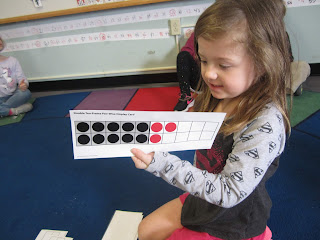A different game had children working with partners to show teen numbers, with one person showing 10 and the other person showing more fingers to make the corresponding teen number. Learning to compose and decompose teen numbers into 10 ones and some more ones lays the foundation for understanding place value and the base ten system.
Friday, February 22, 2019
During February, Number Corner part of our focus has been on teen numbers. Children have learned to think of teen numbers as 10 ones and some additional ones. To reinforce this concept we have been playing a game called capture the teen number. The class is split into two teams, orange and blue. Team members take turns flipping a teen card and covering the corresponding number on the number line with a sticky note that matches their team's color. The cards we use are double ten frame cards, with the first 10 dots shown in black and the rest of the dots in red. We have worked on strategies for quickly identifying the quantity without counting all of the dots. Some examples are touching the black dots and saying 10 and then counting on for the red dots (10...11, 12, 13) and looking for familiar number combinations such as doubles. Many children are now able to immediately recognize how many red dots are showing and can name the teen number. When children identify the number instantly I ask them to share how they know so quickly. Some of their explanations include ideas like "I saw 3 dots on top and 2 on the bottom and I know 3 and 2 is 5," "I saw 4 dots like on a dice and one more and I know 5 is one more than 4," and "There are 2 empty spaces and I thought one empty space would mean 9, so 2 empty spaces is 8."
A different game had children working with partners to show teen numbers, with one person showing 10 and the other person showing more fingers to make the corresponding teen number. Learning to compose and decompose teen numbers into 10 ones and some more ones lays the foundation for understanding place value and the base ten system.
A different game had children working with partners to show teen numbers, with one person showing 10 and the other person showing more fingers to make the corresponding teen number. Learning to compose and decompose teen numbers into 10 ones and some more ones lays the foundation for understanding place value and the base ten system.
Subscribe to:
Post Comments (Atom)












No comments:
Post a Comment
Note: Only a member of this blog may post a comment.